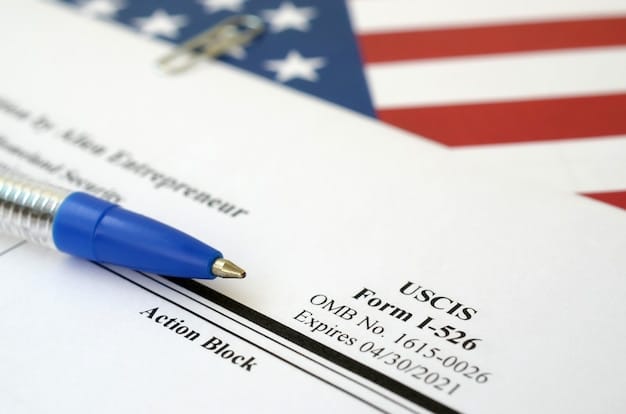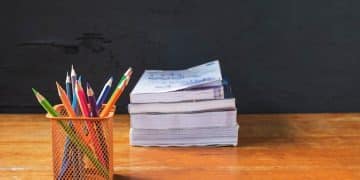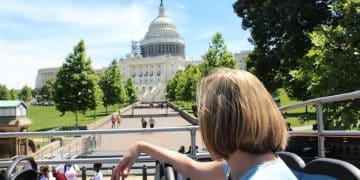Federal Student Loan Forgiveness: Your Complete Guide 2024

Federal Student Loan Forgiveness Programs offer eligible borrowers avenues to have their federal student loan debt cancelled after meeting specific requirements, providing financial relief and a fresh start.
Navigating the complex world of student loans can be daunting, especially when facing the burden of repayment. Fortunately, the US government offers several federal student loan forgiveness programs designed to alleviate this burden for eligible borrowers. This comprehensive guide will walk you through the various programs available, their eligibility requirements, and the application process, empowering you to take control of your financial future.
Understanding Federal Student Loan Forgiveness Programs
Federal student loan forgiveness programs are initiatives created by the US government to provide relief to borrowers struggling to repay their federal student loans. These programs offer the possibility of having a portion or the entirety of the loan balance forgiven after meeting specific criteria, such as working in a qualifying public service job or making a certain number of qualifying payments on an income-driven repayment plan.
These programs are not a free pass, but rather a lifeline designed to help individuals who have dedicated their careers to serving the public or who are experiencing financial hardship due to student loan debt.
Types of Federal Student Loans Eligible for Forgiveness
Not all student loans are created equal when it comes to forgiveness programs. Generally, federal student loans are eligible, while private student loans are not. Here’s a breakdown:
- Direct Loans: These loans are eligible for most federal student loan forgiveness programs.
- Federal Family Education Loan (FFEL) Program Loans: These loans may be eligible if consolidated into a Direct Consolidation Loan.
- Perkins Loans: These loans may be eligible under specific Perkins Loan cancellation programs or if consolidated into a Direct Consolidation Loan.

It’s crucial to determine the type of federal student loans you have to understand your forgiveness options.
Understanding the types of loans eligible is the first step. Next, we’ll explore the specific forgiveness programs.
Public Service Loan Forgiveness (PSLF)
The Public Service Loan Forgiveness (PSLF) program is one of the most well-known federal student loan forgiveness initiatives. It’s designed to encourage individuals to pursue careers in public service by offering loan forgiveness after a certain period of qualifying employment and payments.
This program can be a significant benefit for those dedicated to working in fields that serve the public good.
Eligibility Requirements for PSLF
To be eligible for PSLF, borrowers must meet the following requirements:
- Qualifying Employment: Be employed full-time by a qualifying employer, which includes government organizations (federal, state, local, or tribal) and certain non-profit organizations that are tax-exempt under Section 501(c)(3) of the Internal Revenue Code.
- Qualifying Loans: Have Direct Loans (or consolidate other federal student loans into a Direct Consolidation Loan).
- Qualifying Repayment Plan: Repay your loans under an income-driven repayment plan (IDR).
- Qualifying Payments: Make 120 qualifying payments (10 years) while working full-time for a qualifying employer.
How to Apply for PSLF
The application process involves several steps:
- Confirm Qualifying Employment: Use the PSLF Help Tool on the Federal Student Aid website to verify that your employer qualifies.
- Submit Employment Certification Forms (ECFs): Submit ECFs annually or whenever you change employers to ensure your employment qualifies.
- Apply for PSLF: After making 120 qualifying payments, submit the PSLF application.
The PSLF program is a powerful tool for individuals dedicated to public service, but it requires careful planning and adherence to the specific requirements.
Income-Driven Repayment (IDR) Forgiveness
Income-Driven Repayment (IDR) plans are designed to make student loan payments more affordable by basing them on your income and family size. Several IDR plans offer loan forgiveness after a specified repayment period, typically 20 or 25 years.
IDR forgiveness provides a safety net for borrowers who may not qualify for other forgiveness programs but are still struggling to manage their loan debt.

Types of Income-Driven Repayment Plans
There are four main IDR plans:
- Income-Based Repayment (IBR): Payments are capped at 10% or 15% of discretionary income, depending on when you received your loans.
- Pay As You Earn (PAYE): Payments are capped at 10% of discretionary income.
- Revised Pay As You Earn (REPAYE): Payments are capped at 10% of discretionary income, but this plan is available to a broader range of borrowers.
- Income-Contingent Repayment (ICR): Payments are based on income, family size, and loan balance.
How to Apply for IDR Forgiveness
To pursue IDR forgiveness:
- Choose an IDR Plan: Select the IDR plan that best suits your financial situation.
- Make Qualifying Payments: Make the required payments for the specified repayment period (20 or 25 years).
- Apply for Forgiveness: After the repayment period, apply for forgiveness through your loan servicer.
IDR forgiveness offers a long-term solution for managing student loan debt, providing eventual forgiveness after consistent payments.
Teacher Loan Forgiveness Program
The Teacher Loan Forgiveness Program is designed to encourage qualified teachers to work in low-income schools. This program offers loan forgiveness to teachers who meet specific requirements.
This program is a great way to get student loan forgiveness faster by serving in low-income communities.
Eligibility Requirements for Teacher Loan Forgiveness
To be eligible, teachers must:
- Be a Qualified Teacher: Be a highly qualified full-time teacher.
- Teach at a Qualifying School: Teach for five consecutive years at a low-income school.
- Eligible Loans: Have Direct Loans or FFEL Program loans.
How Much Can You Have Forgiven?
Eligible teachers can receive up to $17,500 in loan forgiveness if they teach math, science, or special education. Other qualified teachers may receive up to $5,000 in loan forgiveness.
The Teacher Loan Forgiveness Program is a valuable incentive for teachers dedicated to educating students in underserved communities.
Other Federal Student Loan Forgiveness Programs
In addition to the major programs, several other targeted forgiveness options exist.
These specialized programs can provide relief to borrowers in specific circumstances.
Closed School Discharge
If your school closes while you’re enrolled or shortly after you withdraw, you may be eligible for a Closed School Discharge. This program cancels your federal student loans if you meet specific requirements.
Borrower Defense to Repayment
If your school misled you or engaged in other misconduct, you may be eligible for Borrower Defense to Repayment. This program allows you to seek loan forgiveness if your school violated certain laws or regulations.
Total and Permanent Disability Discharge
If you become totally and permanently disabled, you may be eligible for a Total and Permanent Disability (TPD) Discharge. This program cancels your federal student loans if you meet the disability requirements.
Exploring all available forgiveness programs is essential to determine the best option for your individual circumstances.
Navigating the Application Process and Avoiding Pitfalls
Applying for federal student loan forgiveness programs can be complex. Here are some tips to navigate the process and avoid common mistakes.
Careful attention to detail and thorough documentation are crucial for a successful application.
Keep Detailed Records
Maintain detailed records of all your loan documents, payment history, and employment certifications. This documentation will be invaluable during the application process.
Meet Deadlines
Pay close attention to application deadlines and submit all required documents on time. Missing deadlines can result in delays or denial of forgiveness.
Beware of Scams
Be wary of companies that promise quick or guaranteed loan forgiveness for a fee. These are often scams. Only work with your loan servicer or the US Department of Education.
Staying informed and proactive is key to successfully navigating the federal student loan forgiveness landscape.
| Key Point | Brief Description |
|---|---|
| 🧑🏫 PSLF Program | Forgives loans for public service employees after 120 qualifying payments. |
| 💰 IDR Forgiveness | Offers forgiveness after 20-25 years of income-driven repayment. |
| 🍎 Teacher Loan Forgiveness | Provides up to $17,500 in forgiveness for teachers in low-income schools. |
| ✔️ Application Tips | Keep records, meet deadlines, and beware of scams when applying. |
Frequently Asked Questions (FAQs)
▼
To qualify for PSLF, you must work full-time for a qualifying employer, have Direct Loans, repay under an income-driven repayment plan, and make 120 qualifying payments.
▼
IDR plans base your monthly loan payments on your income and family size. After 20 or 25 years of qualifying payments, the remaining balance is forgiven.
▼
Generally, Direct Loans are eligible for most programs. FFEL and Perkins Loans may be eligible if consolidated into a Direct Consolidation Loan.
▼
Teachers who teach for five consecutive years in low-income schools may be eligible for up to $17,500 in loan forgiveness under the Teacher Loan Forgiveness Program.
▼
To apply, gather all required documents, verify your eligibility, submit your application on time, and maintain detailed records of your application process.
Conclusion
Federal student loan forgiveness programs offer a vital lifeline for many borrowers, providing a path to financial relief. By understanding the various programs, their eligibility requirements, and the application process, you can take proactive steps toward managing your student loan debt and achieving financial freedom. Stay informed, keep detailed records, and seek guidance from your loan servicer to navigate the complexities of these programs effectively.





